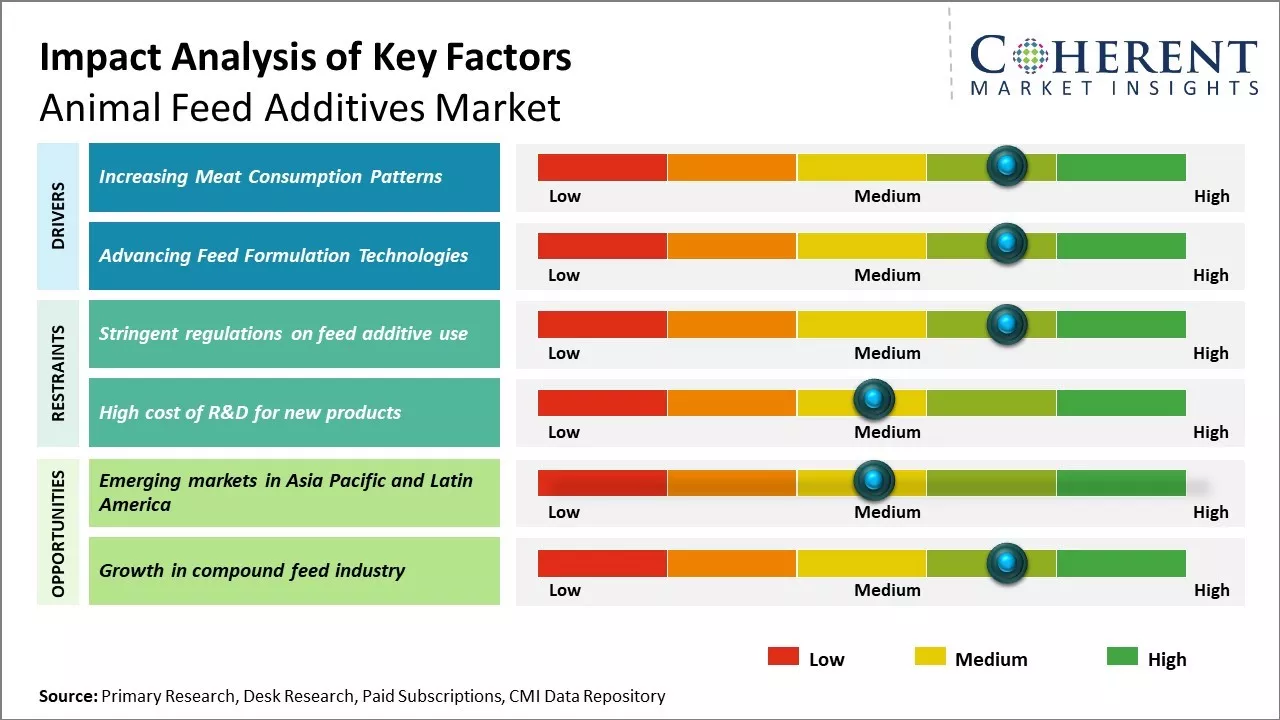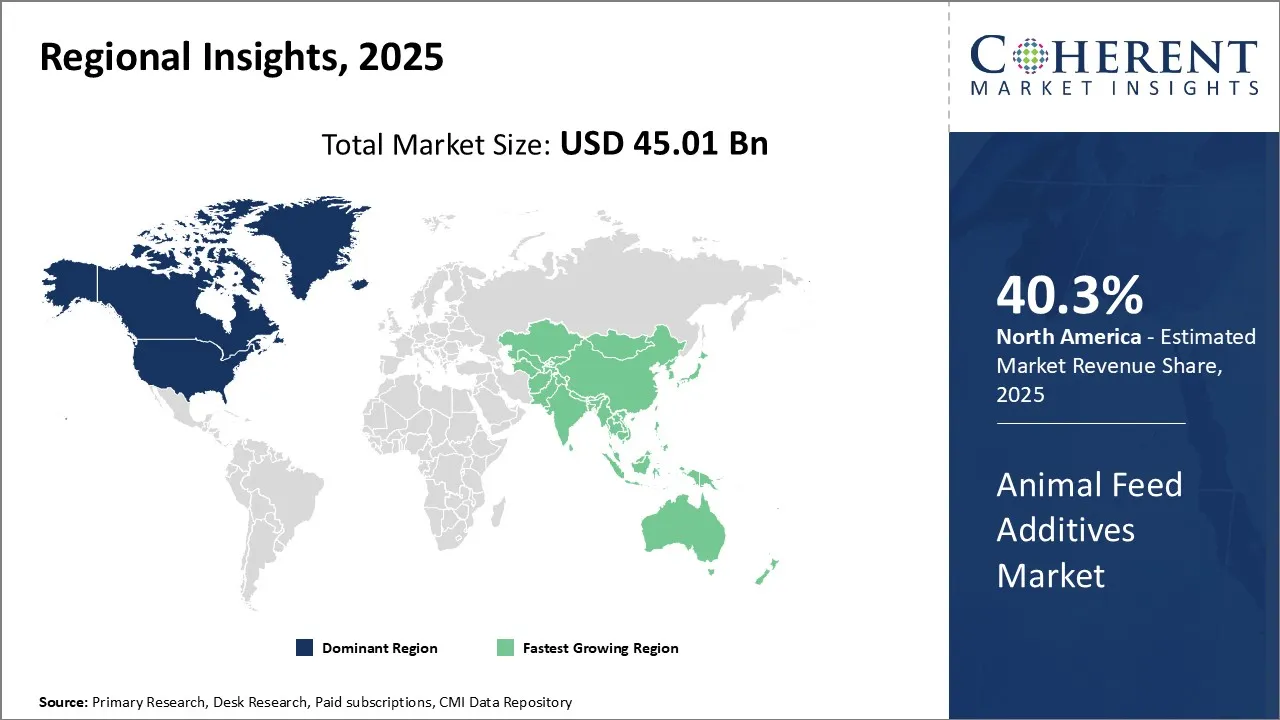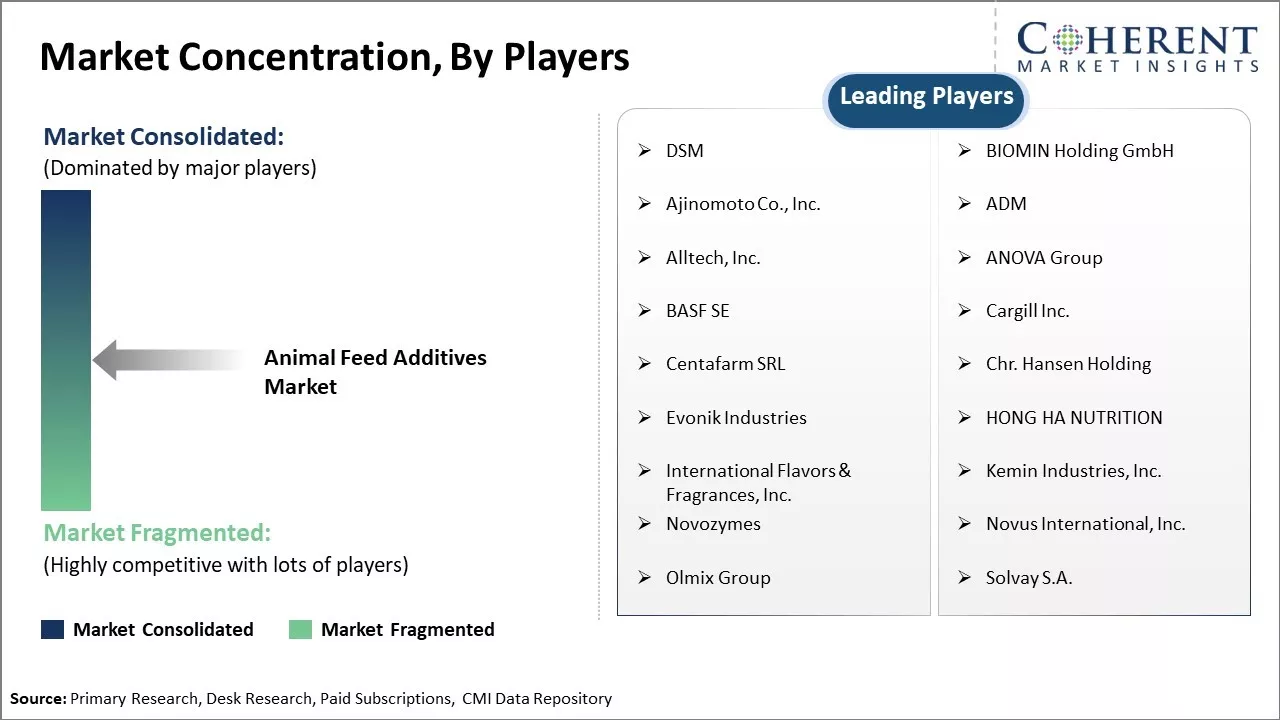The animal feed additives market is estimated to be valued at USD 45.01 Bn in 2025 and is expected to reach USD 57.69 Bn by 2032, exhibiting a compound annual growth rate (CAGR) of 3.6% from 2025 to 2032.

To learn more about this report, Download Free Sample
The increased demand for animal protein and rise in awareness about animal health are major factors driving the animal feed additives market growth. The market is witnessing increasing demand for natural feed additives from livestock producers as they are considered safer alternatives to antibiotics and growth promoters. Consumers are also more inclined towards animal products like meat and milk from livestock fed natural feed additives. There is growing popularity of probiotics, prebiotics, enzymes, and acidifiers as natural feed additives. Manufacturers are investing in the development of innovative and customized formulations of natural feed additives targeted for specific livestock such as poultry, ruminants, swine, and aquaculture. This is expected to propel the animal feed additives market expansion during the forecast period.
|
Current Event |
Description and its Impact |
|
Regulatory Shifts Toward Sustainability and Antibiotic Alternatives |
|
|
Alternative Protein Revolution and Feed Innovation Technologies |
|
Uncover macros and micros vetted on 75+ parameters: Get instant access to report
In terms of livestock, the poultry segment is expected to account for 43.8% share of the animal feed additives market in 2025, driven by the global surge in poultry consumption, particularly in developing regions where chicken and eggs serve as affordable and protein-rich dietary staples. Poultry farming is highly intensive, requiring optimized feed formulations to maintain health, growth rates, and feed conversion efficiency. As a result, poultry feed incorporates a wide range of additives, including amino acids, enzymes, vitamins, and probiotics, to support rapid development and disease resistance.
The poultry sector also benefits from shorter production cycles and higher turnover compared to other livestock, making it a prime target for additive innovation. Additionally, rising consumer demand for antibiotic-free and organic poultry products is encouraging producers to adopt natural and functional feed additives. These trends collectively position poultry as the most influential segment in shaping the future of animal feed additive strategies.
For instance, in October 2025, Alembic Pharmaceuticals and Amlan International introduced Minertox Z and Minertox A, two new feed additives for poultry in India. Designed to enhance gut health and toxin control, these products aim to improve bird performance and support sustainable poultry farming. The launch reflects growing demand for advanced nutrition solutions in India’s livestock sector.
In terms of product type, the amino acids segment is leading with the largest share of the market in 2025, as it plays a critical role in improving feed efficiency, promoting growth, and enhancing the overall health of livestock. Their dominance is driven by the increasing demand for high-performance animal nutrition, especially in poultry and swine production, where amino acids like lysine, methionine, and threonine are widely used to optimize protein synthesis and reduce nitrogen waste. These additives help producers meet sustainability goals while maintaining productivity, making them a preferred choice over traditional options like antibiotics and vitamins.
For instance, in Septmber 2025, BEWITAL agri launched its BEWI-FATRIX® range of rumen-protected amino acids, including methionine and lysine, for dairy cattle in the UK and Ireland. Using advanced cryotechnology, these additives enhance protein synthesis and liver function while reducing nitrogen excretion, supporting sustainable and efficient dairy production. The innovation aligns with growing demand for eco-friendly livestock nutrition.

To learn more about this report, Download Free Sample
North America has established itself as the leading regional market for animal feed additives. The region is expected to account for 40.3% share of the market in 2025. The U.S. and Canada account for the bulk of demand owing to a strong presence of large-scale commercial livestock farming. Major feed additive producers have their headquarters located in the region allowing for efficient domestic supply and consolidation of global operations. Customers benefit from good access to new products and formulation expertise from these industry-leading companies. Well-established import/export infrastructure facilitates cross-border trade complementing the local production capabilities. Furthermore, the regional market benefits from regulatory consistency across jurisdictions helping stakeholders comply with various requirements smoothly.
For instance, in September 2025, ADM and Alltech announced a new joint venture to advance animal feed solutions across North America. Combining ADM’s global nutrition expertise with Alltech’s innovation in feed additives, the partnership aims to deliver sustainable, high-performance products for livestock producers, addressing evolving industry demands and supporting responsible farming practices.
The Asia Pacific region is witnessing the fastest growth in the animal feed additives market. Rapid economic development and urbanization have increased meat consumption in countries such as China, India and Indonesia. Local producers are expanding their operations aggressively to fulfil the growing protein demand from a burgeoning middle class. This, coupled with the desire to ensure nutritional adequacy and health of livestock, is driving additive adoption. Manufacturers from other parts of the world are entering strategic partnerships with regional players and setting up local manufacturing plants to capitalize on the opportunities. For instance, in September 2025, Ecolex and CJ Bio announced a strategic partnership to serve the South Asian poultry market. The collaboration aims to deliver sustainable feed solutions by combining Ecolex’s expertise in palm oil derivatives with CJ Bio’s amino acid innovations. This alliance supports regional demand for high-performance, eco-friendly poultry nutrition.
Local governments also recognize the importance of this industry in achieving self-sufficiency in agriculture and food production. They offer production-linked incentives to boost domestic supply further. Transportation costs give regional suppliers a competitive advantage over imports as well. Rising prosperity will continue augmenting demand for affordable animal proteins in Asia Pacific, thereby acting as a macro driver for feed additive usage.
The U.S. animal feed additives market is thriving due to rising meat consumption, advanced livestock farming practices, and strict nutritional standards. Producers seek additives to boost animal health, feed efficiency, and sustainability. Regulatory support and innovation in amino acids, enzymes, and probiotics further fuel market growth.
For instance, in September 2024, U.S.-based Novus International partnered with a biotech company to develop next-generation animal feed additives. The collaboration aims to enhance livestock health and productivity through innovative, science-driven solutions. This strategic move supports sustainable agriculture and reflects growing demand for advanced nutrition technologies in the global animal feed industry.
India’s animal feed additives market is growing rapidly due to rising awareness of livestock nutrition, expanding commercial farming, and government support for animal husbandry. Increasing demand for quality meat, milk, and eggs, along with innovations in sustainable and natural additives, is driving adoption across poultry, cattle, and aquaculture sectors.
For instance, in August 2025, DSM-Firmenich inaugurated a new Animal Nutrition and Health plant in Jadcherla, India, to meet growing regional demand for sustainable livestock solutions. The facility enhances local production capabilities and supports innovation in feed additives, reinforcing the company’s commitment to advancing animal health and nutrition across South Asia.
| Report Coverage | Details | ||
|---|---|---|---|
| Base Year: | 2024 | Market Size in 2025: | USD 45.01 Bn |
| Historical Data for: | 2020 To 2024 | Forecast Period: | 2025 To 2032 |
| Forecast Period 2025 to 2032 CAGR: | 3.6% | 2032 Value Projection: | USD 57.69 Bn |
| Geographies covered: |
|
||
| Segments covered: |
|
||
| Companies covered: |
DSM, BIOMIN Holding GmbH, Ajinomoto Co., Inc., ADM, Alltech, Inc., ANOVA Group, BASF SE, Cargill Inc., Centafarm SRL, Chr. Hansen Holding, Evonik Industries, HONG HA NUTRITION, International Flavors & Fragrances, Inc., Kemin Industries, Inc., Novozymes, Novus International, Inc., Olmix Group, and Solvay S.A. |
||
| Growth Drivers: |
|
||
| Restraints & Challenges: |
|
||
Uncover macros and micros vetted on 75+ parameters: Get instant access to report
Rising global meat consumption is a key driver of Animal Feed Additives Market demand. As incomes, urbanization, and population growth surge, especially in developing regions—dietary preferences shift toward poultry, pork, and beef. This increases livestock production, prompting farmers to prioritize animal health and productivity. Feed additives like probiotics, prebiotics, enzymes, and antioxidants enhance feed efficiency and support growth. With stricter regulations and growing awareness, producers are investing in affordable, science-backed additives. The trend is expected to accelerate market expansion, particularly in emerging economies, where demand for sustainable and cost-effective animal nutrition solutions continues to rise.

To learn more about this report, Download Free Sample
A major future opportunity in the animal feed additives market is the rise of natural, plant-based alternatives to antibiotics and synthetic growth promoters. With growing concerns over antimicrobial resistance and consumer demand for clean-label meat, additives like essential oils, probiotics, and algae-based supplements are gaining traction. These compounds enhance gut health, immunity, and nutrient absorption, offering sustainable solutions for livestock productivity. As regulations tighten and precision farming advances, the shift toward eco-friendly feed additives is expected to reshape animal nutrition, aligning industry practices with health-conscious and environmentally responsible standards.
The animal feed additives market is shifting from broad-based expansion to selective, innovation-led growth. A few integrated multinationals now dominate, leveraging control over amino acid capacity and global distribution networks to dictate pricing and supply. Mid-sized players, in contrast, must compete through specialization in enzymes, probiotics, or tailored premixes.
Policy and commodity dynamics are reshaping demand. China’s initiative to reduce soymeal inclusion from about 13% to 10% by 2030 is a structural turning point, diverting demand toward synthetic amino acids and alternative proteins. Amino acids, especially lysine and methionine, remain the most critical and capacity-sensitive additives, while biological solutions, enzymes, probiotics, and phytogenics are gaining traction as regulators restrict antibiotic growth promoters.
Future winners will be those controlling key inputs, generating validated performance data, and aligning portfolios with sustainability and regulatory shifts. Commodity-based players will see shrinking margins, while firms offering differentiated, high-efficacy biological or amino acid solutions will consolidate leadership. Ultimately, this market rewards technical credibility and supply resilience over mere product presence or volume growth.
Definition: The animal feed additives market consists of various components and supplements that are added to animal feed to improve the quality of the feed as well as support overall health, growth and development of livestock. Common animal feed additives include vitamins, amino acids, fatty acids, minerals, enzymes, and other nutritional supplements used primarily in poultry, cattle, swine and aquatic animal feed to enhance digestibility, improve feed conversion, promote growth and prevent diseases. The global animal feed additives market is seeing steady gains as demand for meat and dairy products rises around the world.
Share
Share
About Author
Pankaj Poddar is a seasoned market research consultant with over 12 years of extensive experience in the fast-moving consumer goods (FMCG) and plastics material industries. He holds a Master’s degree in Business Administration with specialization in Marketing from Nirma University, one of India’s reputed institutions, which has equipped him with a solid foundation in strategic marketing and consumer behavior.
As a Senior Consultant at CMI for the past three years, he has been instrumental in harnessing his comprehensive understanding of market dynamics to provide our clients with actionable insights and strategic guidance. Throughout his career, He has developed a robust expertise in several key areas, including market estimation, competitive analysis, and the identification of emerging industry trends. His approach is grounded in a commitment to understanding client needs thoroughly and fostering collaborative relationships. His dedication to excellence and innovation solidifies his role as a trusted advisor in the ever-evolving landscape of not only FMCG but also chemicals and materials markets.
Missing comfort of reading report in your local language? Find your preferred language :
Transform your Strategy with Exclusive Trending Reports :
Frequently Asked Questions
Joining thousands of companies around the world committed to making the Excellent Business Solutions.
View All Our Clients